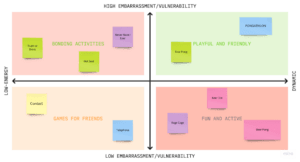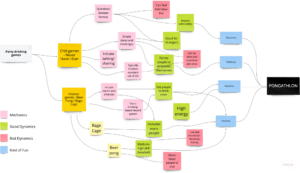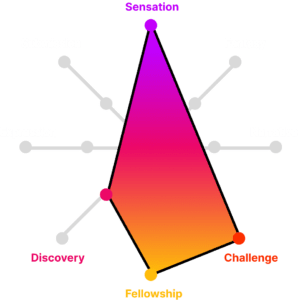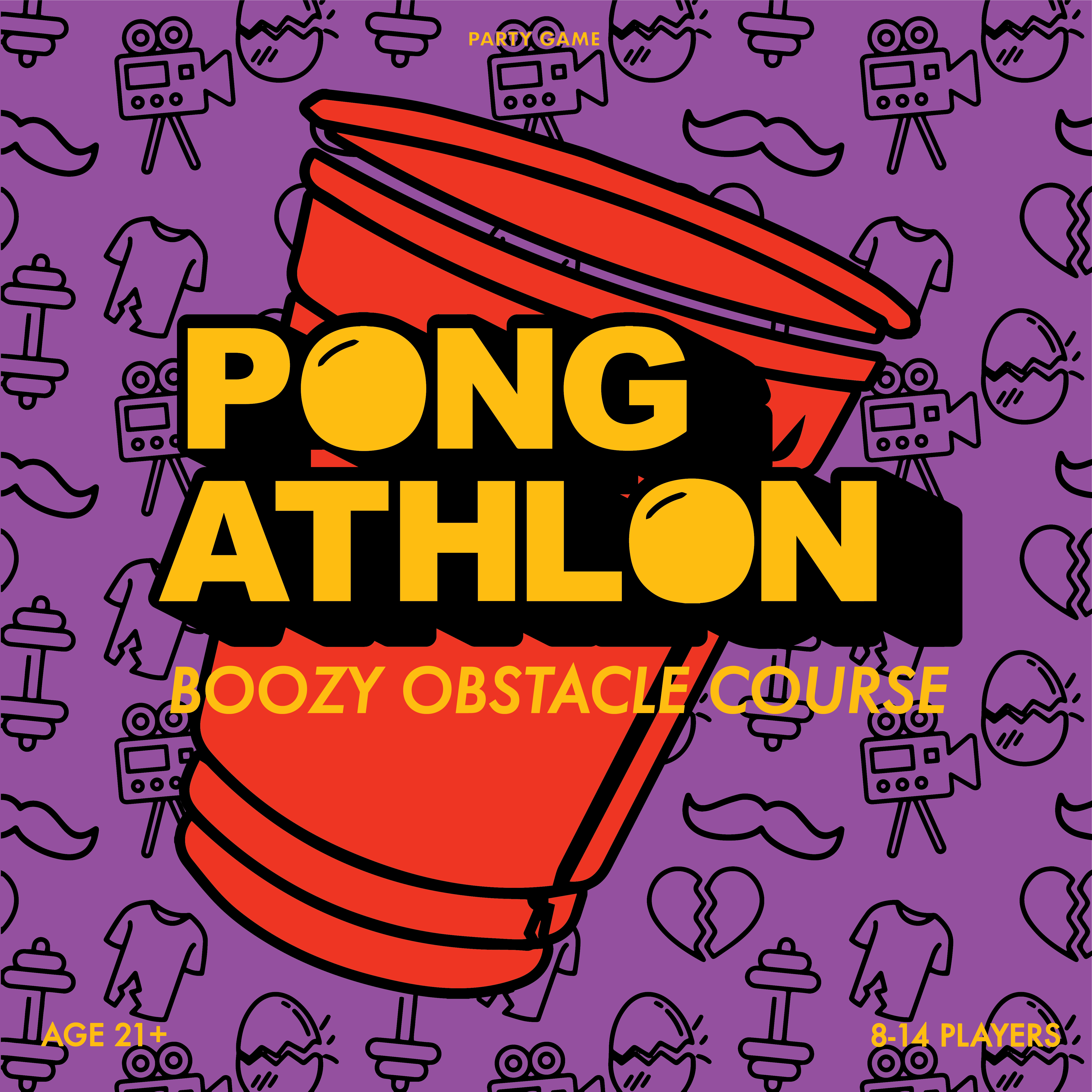By Shreya Shubhangi, Raagavi Ragothaman, Emilio Rivas, Jaylene Martinez
Artist’s Statement
PONGATHLON is a spin-off of the classic beer pong party game, focused on regulating a social dynamic between all players involved. With the inclusion of silly challenges, provocative questions, and cooperative tasks, the game intends to facilitate intimate interactions among the participants that are otherwise absent.
In the majority of party games that are centered around skill-based tasks (throwing ping pong balls into a cup), social interactions are limited to one’s team and often revolve around gameplay. PONGATHLON creates a hectic yet enjoyable environment where the task at hand becomes less important and instead the players shift their attention to getting to know their teammates and opponents better through cooperation and humiliation.
Concept Maps
The prompt we were working off of was ‘beer pong relay’ so we really wanted to scope out where beer pong fits in the scheme of popular party games and understand the gap that our game would have been trying to fill. There were 2 major categories of adult party games that we focused on: 1) Challenge and vulnerability-based group games and 2) ‘sporty’ party games like beer pong and die.

We mapped out our game and a few others along 2 axes: 1) energy and dynamism and 2) the extent of embarrassment/vulnerability it evoked. As you can see in the 2×2 above, the majority of drinking games tend to be either highly active and competitive like Rage Cage or more mellow but exploratory in terms of sharing and vulnerability. We aimed to strike a balance between the two by creating something similar in nature to fear pong, that involves challenge, vulnerability and activity, while ensuring that we improved on the game’s shortcoming of only being playable for 2-4 people.
Using the 2×2 as a starting point we also used the MDA framework to further dissect what exactly made these games fun or not to fun to play and to isolate what elements of these games we wanted to incorporate into PONGATHLON to provide the same social ‘buzz’ as the other games currently popularly do. Some of the mechanics we considered were time and format as well as rules specific games within the major categories.

Doing this helped reveal some of the major dynamics that really made this games fun for people and repeatedly alluring in a party setting. Some of these included how good the game would be for strangers or beginners and the gentle coercion into embarrassing oneself in a very non-judgemental environment. Ultimately, we identified 4 primary kinds of fun that we wanted PONGATHLON to encompass:
- Discovery
- Challenge
- Fellowship
- Sensation
Game Shape

Our goal was to strike the right balance of each of these elements to create something that was not only fun and playable but also unconventional yet comfortable.
Initial Decisions and Values
During the ideation stage, our focus was on creating a social game that was high energy, physical, and just plain ridiculous. It was important to us that our game produced an energetic atmosphere in which people felt comfortable stepping out of their comfort zone and willing to try new things. We drew from Daniel Cook’s patterns for building friendships to create a game that maximizes fellowship and brings people closer than they were prior to playing. We wanted to emphasize Cook’s idea of proximity by making most of the challenges physical tasks so players can grow a sense of physical intimacy with one another. The physical nature of our challenges serve to create a series of conflicts that must be overcome and provide players with sense pleasure. A game involving such challenges requires that players must trust one another. Because of this, our game values and seeks to encourage reciprocity. We wanted the challenges to establish a common ground between the players to further increase the trust between them: “What happens in the Magic Circle, stays in the Magic Circle.” Our formal elements reflect these values and initial design decisions.
Formal Elements
Players
Originally, we intended for our game to be played by a large group of around 12 people (6 people per team). The players engage in a team competition, racing to shoot ping pong balls into cups (color-coded by difficulty) and finish the challenges underneath them.
Objectives
The main objective of the game is to shoot the most cups, complete challenges, and accumulate the most points. In a sense, the objective is to claim as much cup territory as possible and race to finish the respective tasks. However, the objective can vary per player. Some players might derive more fun from seeing their friends/teammates complete hilarious challenges, so their objective may be to aim for more difficult challenges to witness their friends do things they wouldn’t, under any other circumstance, do. Other players may wish to focus solely on strategy to more efficiently complete challenges and gain satisfaction from winning. The former type of player gains joy from the sensational aspect of the game while the latter type of player gains joy from the challenge aspect. Both work together to instill fellowship among players. Our goal is to maximize every element of our game shape to better suit the different goals of each player.
Procedures
Players organize x solo cups into a circle on a table (where x = 2 * number of players), ensuring that the cups are approximately even distribution of easy, medium and hard cups. Under each cup, stick a PONGATHLON card of your chosen category, corresponding to the difficulty level marked by the cup color. Sticky note color corresponds to the category of dare. Proceed by pouring a small amount of drink into each cup. Divide players into two teams on either side of the table, with players taking turns at getting ping pong balls into cups. Players play until the challenges on all the cups have been completed. Each team then tabulates their points. The team with the most points wins. In case of a tie, the tie is broken by comparing the number of cups by category according to decreasing level of difficulty. The team with the highest number of cups wins.
Rules
Player 1 from each team goes first, lands a cup and hands the challenge under the cup over to the next player. Player 2 must complete the challenge to the satisfaction of the other team, land another cup, pass the cup’s challenge and so one. If all players have landed cups and cups remain on the table, the order of players resets and Player 1 takes another turn.
Resources
Each PONGATHLON challenge card is worth points according to the level/difficulty of the challenge: Easy = 1 point, Medium = 2 points, and Hard = 3 points.
Conflict
The conflict at play here is opposition between teams. Players on the same team must work together to shoot as many balls into the cups as they can. They must also trust each other to be willing to complete the challenges and must do so quickly. Each team wants to claim more territory and/or accumulate more points in order to increase their chances of winning.
Boundaries
The boundaries for the game include the entire area in which the party/gathering is taking place. This is because some challenges can require obtaining items from within a house, for example. With that being said, the challenges must be completed within close proximity of the play table so the teams can hold each other accountable for completing the challenges.
Outcome
The game is zero-sum. Once a team has accumulated more points than the other, the game ends with that team’s victory and the other team’s loss.
Testing and Iteration History
In total, we fully tested our game with 2 groups and walked through our game format and challenges with 1 group.
Playtest #1
During our first playtest, because of the layout of our lecture room, we changed the main beer pong mechanic and played the game in a more rage cage format, where all the cups were in the center and the playing members of the team attempted to bounce the ball on the table into a cup. Our testers’ feedback ended up being that the game was a little too fast paced and chaotic, especially because of the limited table space. Another big piece of feedback we received from this playtest was that it would be more entertaining if team 1 had to do the challenges for the cup corresponding to team 2’s toss.
Playtest #2
For our second “playtest”, the team just looked at our challenges and rules. The main feedback from this group of people was that the challenges seem a bit extreme and that not all groups of people might want to do the set of challenges. Their suggestion was to create a tamer version of the cards or create a penalty for not wanting to complete a challenge.
Playtest #3
For our last playtest, we played the game as originally intended with a beer pong setup – this round was definitely the most insightful. While we found that people found the rage cage format too fast paced in the first play test, in this round, our play testers found the pace of beer pong a bit too slow. We also observed that there was general confusion regarding the ‘relay’ part – both sides didn’t really understand who should be shooting the ball. On the plus side, we found that for the challenges that the playtesters could do (non food or household item related), they really committed to them and seemed to be having a good time playing the game. We got the piece of feedback again suggesting that we change the game so that teams do the challenges corresponding to cups made by the opposite team.
When we workshopped some of these details amongst us and with our last playtest group, here was our reasoning behind each suggestion:
- Having teams do opposite team challenges: This makes sense and seems to be more fun for players. It also eliminates any mental calculations that players might need to do on whether they should aim for cups with easier or harder challenges to give to their teammates. We can account for the cups and challenge points separately so that teams get points for getting the ball in a cup and also doing challenges assigned by the opposite team.
Creating a separate deck: Since our game is specifically intended to be played in a party setting, we want to keep our challenges pretty wild, so it lowers players’ inhibitions. We really debated this because we wanted to make this game classroom friendly, but in our final playtest, we found that people were generally willing to do the challenges.
Final Playtest
The Final Version
Box Design

Print-n-Play + Rulesheet





